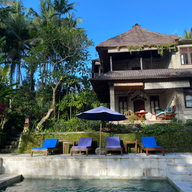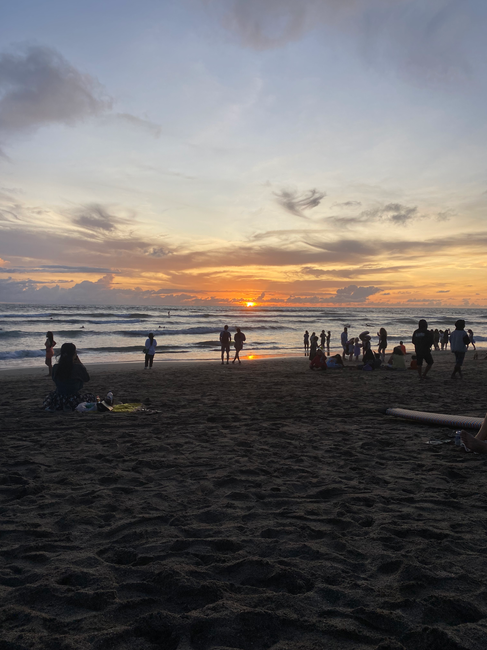
For the first time since I started this blog, I can officially say that this one about Bali is a super anticipated article (by no less than four or five people who actually asked me for it!).
As some of you may already know - and if you don't, go and check out all the stories highlight on my instagram profile - I spent a week on Indonesia's most famous island in January, on my way back from my trip to Australia (a post on that will be coming soon too).
I'll be honest, Bali being such a popular destination among cool influencers I was a bit sceptical and was really afraid of disappointing my high expectations. But instead folks (can I say folks?), everything they say about Bali is the absolute truth!
In this post, therefore, I tell you about all the wonderful places I visited, and give you a few more tips on how best to prepare for the trip.
Having only a week to spend in Bali, I had to plan the itinerary well and only list the destinations that convinced me 100%; it was tough, but I think I did a great job in balancing cultural visits, nature and relaxation. A special mention goes to JustTrip, a new app that makes travel planning very easy and really intuitive (not just for Bali, but for so many other tourist spots). Although I am biased, knowing the creator very well, I can say that it really helped me a lot in choosing my points of interest and I really recommend downloading it (if you do, let me know what you think).
I spent the first three nights in Ubud, in the interior of the island - this allowed me to get in touch with Bali's religious sites, culture and traditions. The last nights, on the other hand, I spent in Canggu, a small town on the southern coast, where I was able to enjoy some sea and sun before returning to Italy.
I also leave you a list of information and tips at the end of the article that were very useful to me before and during the trip, I hope they can help you should you decide to visit Bali.
As always, you can find the complete map of the entire itinerary (sacred places, beaches, restaurants, spas, gyms etc.) either at the end of the page or by clicking here.
Ubud: Saraswati Temple, Sacred Monkey Forest and Ubud Palace
The first thing to do once you arrive in Ubud is to take your time to visit all the sights and points of interest there. Not having much time and my schedule being quite paced, I woke up very early in the morning and, after checking the map well and having a nice massage (one of the most beautiful massages in the history of wonderful massages, price about 15€, rating 5/5 - Jaens Spa), I started my unguided tour of the city.
Despite the heat and humidity, I decided to move between the various places on foot, so that I could stroll through the characteristic streets and have a chance to stop at all the different shops I found on the way.
Saraswati Temple
One of Ubud's main attractions is undoubtedly the Saraswati Temple, very famous for the two lotus ponds surrounding the main entrance road; it is a temple dedicated to the Hindu goddess of wisdom, music and art. Admission is free and, on certain days of the week, it hosts the typical and beautiful Balinese dance ceremonies.
Right next to the temple, there is also the Ubud town market, where you can stop and buy typical clothing and local souvenirs.
Sacred Monkey Forest
On the way to another of Ubud's most famous attractions, I stopped for a drink at a wonderful place that my friend Sophie had recommended (by now, if you have read any other posts, you should know her), the Folk Pool & Garden - a sort of wonderful club with a pool and bar (the bar counter is right in the pool!!) where you can relax and spend a few hours away from the chaotic traffic of Bali.
The Sacred Monkey Forest is definitely a place to visit, perhaps the city's main attraction. This small rainforest is home to around 700 Balinese monkeys that wander among the temple and trees. Be careful of the monkeys! Always put all personal belongings in your bag, avoid carrying plastic bags, food and never look them in the eye (otherwise they take it as a sign of defiance). I learnt this to my cost, after a cute monkey stole my beautiful glasses and munched them all up. The only way you usually get back what was stolen is to barter it for food. The entrance fee is about 5€.
Ubud Palace
The last attraction I visited on my first day, but not least, was the Ubud Palace.
The building has a simple architectural style and is a classic example of Balinese architecture that has been well preserved.
Balinese dance performances are held here every evening at 7.30 p.m. (of which I leave photos and videos) and are definitely worth seeing. The entrance fee is about 5€, just go a few minutes before the start of the show.
Ubud surroundings: Tegalalang Rice Terrace, Coffee Plantations, Mount Batur, Tirta Empul and Goa Gojah
To visit all the places of my interest slightly outside the town, but still around the Ubud area, I decided to hire a private driver. In Bali, as in many other Asian countries, organising a private tour is often much more convenient, especially if you don't have much time. I don't recommend a particular driver, because there is a lot of availability and it is usually the hotel/villa where you are staying that organises it. I limited myself to choosing between half-day or full-day tours, opting for the latter, and listing some of the places I wanted to visit (carefully chosen through JustTrip). The driver himself then suggested some small changes that were more in line from an organisational point of view.
I leave below the tour I took during the day.
Tegalalang Rice Terrace
The Tegalalang Rice Terrace are among the most famous (and enchanting) attractions on the island and, for this reason, among the most crowded; I recommend arriving early enough in the morning to avoid long queues.
This incredible place is part of the cultural landscape of the UNESCO World Heritage province of Bali and includes these emerald green hills where local rice is cultivated. Within the rice paddies, there are also many spots where you can go on swings suspended in the air and enjoy a wonderful view from above. If I remember correctly, the entrance and the swing ride cost me between €10 and €20.
Coffee Plantations (Kumulilir)
On the way to Mount Batur, the driver asked me if I wanted to make a short stop at a coffee and tea plantation and I, being the caffeine-obsessed person that I am, accepted without hesitation. We then arrived at this very nice place run by a very friendly staff: a girl took me on a tour of the plantation and explained step by step how the production of all the types of coffee on the plantation takes place.
I even discovered that Indonesia produces one of the world's finest qualities of coffee, Kopi Luwak, made from the poop - you got it right, p-o-o-p - of animals. At the end of the tour, the girl served me samples of all types of coffee and tea produced by them (all free!).
Mount Batur
One of the things I really wanted to do was the famous trek up Mount Batur. Batur is a majestic active volcano that is part of the UNESCO Global Geoparks network. They say that at dawn the sky is incredible from up there and that the colours and the view are worth the effort it takes to get to the top. Unfortunately, the trek takes several hours and you have to leave late at night. Since my days were really numbered, I had to give up this adventure, but I still managed to get a nice view from the terrace of a restaurant not too far away.

Tirta Empul Holy Water Temple
The visit to the Tirta Empul Holy Water Temple (literally 'The Temple of the Gushing Holy Water') was very powerful for me. The structure is an architectural complex, consisting of a set of temples and water springs that flow directly from a sacred mountain near the temple itself.
In the central courtyard are two pools of water with several spouts, adorned with various sculptures, and used for the purification rite. After solemn prayers at an altar nearby, pilgrims enter the first pool and approach the first spout. Keeping their hands clasped, they bow under the water flowing from it, continuing from the first to the last in the series.
The purpose of the ritual is to purify body, soul and mind to make way for new life and energy - 'I wash away all that I do not need'.
The ritual is very strict and traditional, which is why I recommend being accompanied by a local person, so that you can be guided while respecting the local culture.
Goa Gojah (Elephant Cave)
The last stop of the day was the Elephant Cave, which is located within an archaeological park. It is thought to have been built around the 9th century AD for use as a sanctuary. It only became known to the Western world, however, in 1923 following the intervention of a group of Dutch archaeologists.
From the architectural style, at least from what my guide explained to me, one can see the coexistence of elements typical of Buddhism and Hinduism.
🏡 Where I stayed in Ubud
One of the most beautiful places I have ever stayed - the Kebun Indah in Ubud. A complex of more or less self-contained cottages, isolated enough from the chaotic and busy centre of Ubud to hear nothing but the noise of nature all around, but not too far away to be able to get there easily on foot along a small avenue.
Perfect location, great staff and always available for help, amazing breakfast / snack, room cleaned every day with great care. I also appreciated that they put a mosquito net outside the room every night. By booking through Booking I got quite a discount, so for me value for money was also a 10/10.
🍛 Where to eat in Ubud
Mild Bistro - 🌱 Vegetarian / Vegan friendly ⭐⭐⭐⭐
AMAZING, with several vegetarian and vegan options and staff very willing to vary the dishes. Prices slightly above the average in Ubud, but compared to Italian prices, still very affordable. Located close to Ubud Palace and Saraswati Temple, in case you are in the neighbourhood.
Dapur Usada - 🌱 Plant-based ⭐⭐⭐⭐
A completely plant-based restaurant with quite distinctive and strong flavours. They have a lot of choice, but if you are a bit inexperienced (like me) about the various ingredients, you have to be guided a bit.
Twist - 🌱 Vegetarian / Vegan friendly ⭐⭐⭐⭐
The BEST CURRY I have ever tasted (with a mix of Tofu and Seitan, I could cry with joy!). A bomb. Fantastic. Nothing else to add.
Canggu and surroundings: Batu Bolong, Tanah Lot, Uluwatu and Nusa Penida
After doing a bit of research, I chose Canggu as my second base to explore the south of the island - a town full of clubs, shops, restaurants and - above all - the sea. As soon as I arrived, I immediately realised that the traffic was even more chaotic than in Ubud: mopeds on the pavements, cars on the wrong side of the road and no apparent rules. Despite this, Canggu really has a lot to offer.
Batu Bolong Beach
Fortunately, the hostel I chose was quite close to both the centre of Canggu and one of the two main beaches, Batu Bolong. This allowed me to avoid traffic, at least on my daily walks from the beach/restaurants to my accommodation.
Batu Bolong is quite a large beach, very famous in Bali for its surfing waves. It doesn't have a jaw-dropping beauty, at least until sunset time - that, however, is really a sight to behold. In fact, I have often returned to see it, without actually even swimming. A beer and a roasted cob on the beach and I couldn't ask for better!
Tanah Lot
From Canggu, it is very easy to reach the famous temple in the sea of Tanah Lot, a marvellous Hindu complex atop an impressive rock formation on the south-west coast of the island of Bali. Tanah Lot literally means 'Land in the Sea' in the local language. At low tide, it is possible to walk up to the main structure, built on a large rock in the middle of the sea.
Pictured: a boomer in its natural habitat
When I went, needless to say, it was high tide - so I just admired its beauty from afar. My photos, compared to those on the internet, are embarrassing to say the least. I therefore refer you back to this site to actually understand what I am talking about.
Uluwatu
Another destination I definitely wanted to visit once I arrived in Canggu is Uluwatu, famous for its impressive temple on the cliff and its beautiful beaches. Also to get to Uluwatu I asked for a lift (this time by scooter) from a very kind driver (link to his Instagram here - Heru is available for different types of tours and I highly recommend him).
The first stop of the day in Uluwatu was this INCREDIBLE beach, which I was not expecting at all, called Padang Padang Beach. A small cove (usually quite crowded) which can be accessed, by paying a couple of euros for the entrance, via a narrow stairway between rocks and monkeys, at the end of which, a veritable paradise opens up with calm, crystal-clear and even warm water! Definitely one of the things I recommend if you are looking for a nice beach to swim in.
From there, we then moved on to the Uluwatu Temple, where one usually goes to admire a picturesque sunset. I came out, however, with glasses crunched by a very cute monkey (video attached) and, guess what, without being able to admire any sunset at all, thanks to a tiny cloud that decided to place itself in front of the sun two minutes before sunset.
Despite this, it is a really beautiful place and well worth a visit. Be careful of the monkeys, though. They are literally out of control!
Nusa Penida
The last place, visited just the day before leaving, was Nusa Penida, an island off the coast south of Bali and easy to reach with organised tours from Canggu. I chose, booking literally the day before and having no idea what was in store for me, to tour the east coast (Atuh and Diamond Beach) and was really pleased.
Before heading to the two beaches, however, we took a trip to these very strange hills that resemble those of the Teletubbies - not surprisingly, they call them Teletubbies hills.
Atuh Beach and Diamond Beach are literally next to each other, one is to the right of an imposing rock and the other to its left. Given the limited time and effort it takes to walk down to these two beautiful beaches, we had to choose to only see one from above (Atuh Beach, pictured below) and walk down to the other.
We therefore chose to visit Diamond Beach - in retrospect I can say that it did not turn out to be an easy choice, given the difficulties we encountered along the way: in addition to some very steep stairs, there were points where you literally had to abseil with a rope, without any protection!
Despite this, however, once you arrive at your destination, the scenery is truly incredible and, if you feel up to it, absolutely worth it. As it is quite a difficult place to reach, there are never many people there and you have plenty of space to relax in peace.
🏡 Where I stayed in Canggu
As I was already aware of the traffic in Canggu, I opted for a solution that was in the centre (on one of the two main roads) but from which it was still easy to walk to the beach. The hostel I chose is called Sunflower Stay and Surf and has both dorms and single rooms with private bathroom, shared kitchen and swimming pool. Not bad, but - in retrospect - I have to say a bit pricey compared to the average in Bali and what it offers.
🍛 Where to eat in Canggu
Crate Cafè - 🌱 Vegetarian / Vegan friendly ⭐⭐⭐⭐
Great for breakfast and brunch - perhaps one of the hottest places in Canggu, with a somewhat industrial style but with affordable prices and huge portions. I sampled their waffles and a smoothie and I must say they were really good.
Motion Café - Fitness Food - 🌱 Vegetarian / Vegan friendly ⭐⭐⭐⭐
Another place I liked a lot, definitely suitable for those who are careful about what they eat (in terms of macro nutrients) but also for those who want to treat themselves to a good healthy meal or protein smoothie.
Chow Chow - 🌱 Vegetarian friendly ⭐⭐⭐⭐
This, on the other hand, is a more dinner-oriented restaurant, very cosy and with super friendly service. They serve Asian / fusion cuisine, with several vegetarian options. I recommend their curry.
Bottega Italiana - 🌱 Vegetarian friendly ⭐⭐⭐⭐⭐
Folks, I am ashamed, but the restaurant I liked best in Canggu is called Bottega Italiana. I went there two nights in a row and the second night I even had two pasta dishes. All very good. It must be said that they probably have Italian ingredients (not all of them), but the sauces are definitely more special than those we eat in the usual Italian restaurants. One example was pasta with courgette and lime sauce on a cheese and hazelnut fondue (GOOD). The nice thing is that you can choose the size of the pasta and the sauce with the combination that inspires you most.
A few more tips
Finally, I leave you with some tips that helped me both before and during the trip.
Before departure:
A very important thing is to apply for the visa in advance - it is done through this site and costs €30. You can also do it directly at the airport, but the queue can be long, so I recommend applying online before departure.
Find out about recommended vaccines (there are no compulsory ones) a few months beforehand. I, for example, (re)got the Typhoid vaccine and had already had the Hepatitis A vaccine in the past. Ask your general practitioner
Inform yourself well about the Covid-19 regulations in place at the time of travel. Today it is still compulsory to present the Covid-19 vaccination certificate, with at least 3 doses
One thing I always find very useful when travelling to Asian countries is to do a cycle of probiotics in the month before departure, it can help a lot in case of Bali Belly 💩
I also recommend buying an E-Sim before you travel, to be activated as soon as you land. This will allow you to not buy a physical SIM to have to plug into your phone, but do everything online without having any problems (check your phone is among the list of enabled ones). I purchased mine here. The only thing that is a bit tedious is that to activate the E-Sim you have to scan a QR code that is sent by email, and which is then on the same phone that you have to use to scan - if you are travelling alone, it can be a bit tricky
Indonesia is a tropical country and, as such, is at risk of mosquito-borne diseases (malaria and dengue). Therefore, equip yourself with long-sleeved shirts and light trousers to wear at dawn and dusk, and remember to carry tropical mosquito sprays (those with a high concentration of DEET, preferably >= 50%).
During the journey:
Remember NOT to DRINK water unless it is sealed or purified, this also means being careful of the ice used in various cocktails and be careful when brushing your teeth
As a consequence, avoid eating fruit without peel and raw vegetables (I know, it's difficult with all that fruit exposed on the road, but think of the possible consequences 💩)
BEWARE OF THE MONKEYS - don't pester them, don't take food with you, don't get too close, stow all valuables in your rucksack/bag. And if they steal something from you, know that monkeys like to barter: if you throw food at them, they will give you back the thing they stole from you
The traffic in Bali is something crazy, there are no rules. If you need a lift (by scooter) download GoJek
Remember that menstruating women are forbidden to enter sacred places
Finally, if you feel like doing sport, I leave you three references of incredible places where I trained during the week I spent in Bali: - The Yoga Barn - CrossFit Ubud - Crossfit S2S, Canggu
And here is the map with all the places I visited: sacred temples and sanctuaries, beaches, restaurants, Spas and gyms. I hope it helps you :)
XX,
Giulia













































































































